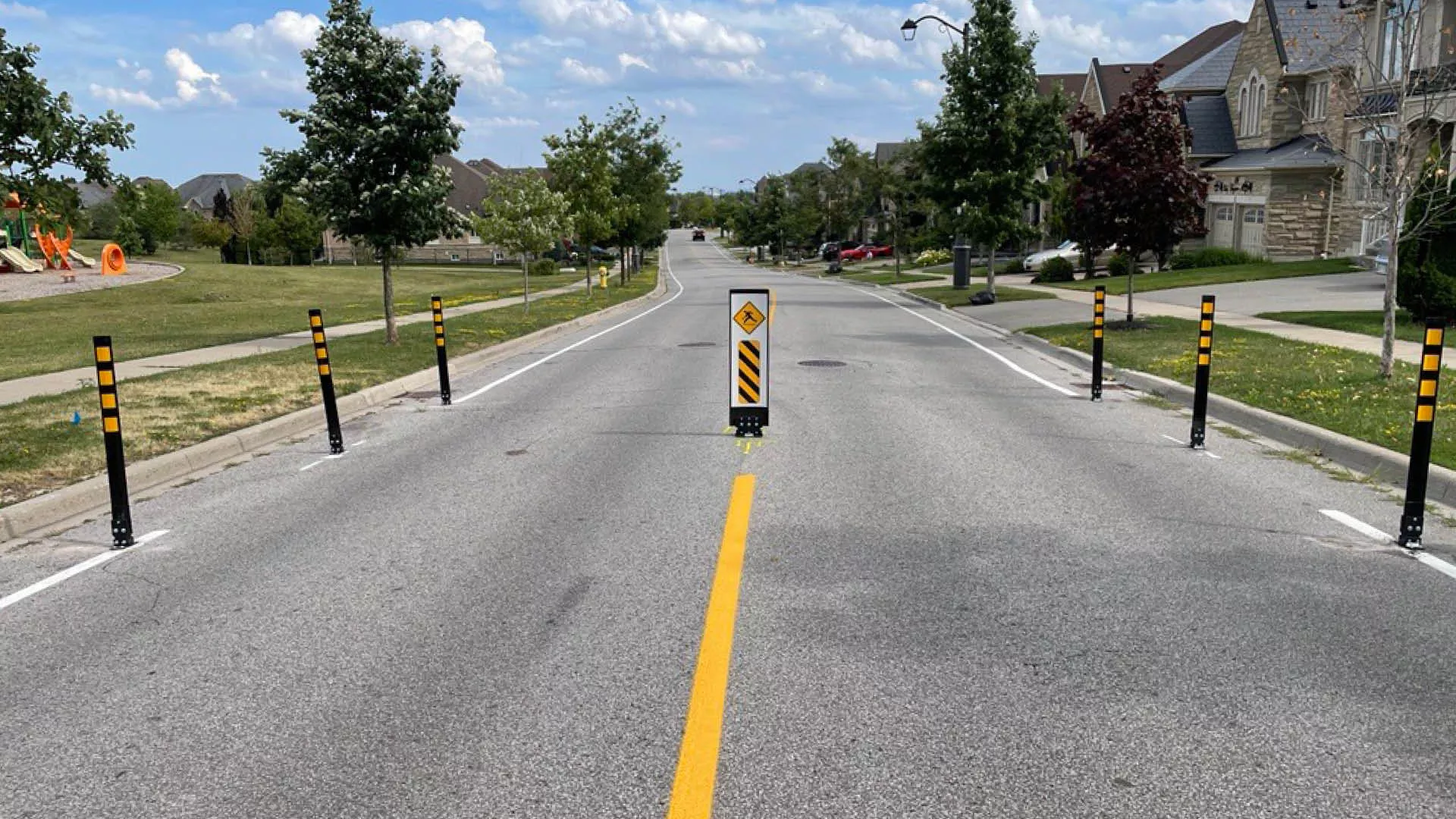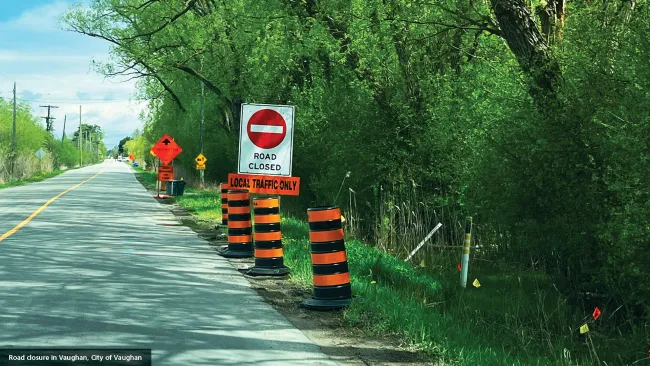What are traffic calming measures and how do they work?
As part of our ongoing commitment to creating safer roads, we’re currently undertaking the Neighbourhood Traffic Calming Plan. A key focus of this project is to create a road network where residential and collector streets – the types lined with homes, schools, neighbourhood parks, local businesses and community centres – are safe, welcoming and comfortable for all road users.
Through this plan, City of Vaughan staff are out installing various traffic calming measures in five pilot neighbourhoods (New Kleinburg, Sonoma Heights, Vellore Village, Carrville Corners and Lakeview Estates). You may have questions about what these measures look like, how they work and how they’ll benefit our city, so we’re sharing some helpful resources:
- Bollards are vertical posts installed at the edge of traffic lanes, typically near the curb. They narrow the road, guide traffic and encourage drivers to slow down so they can pass through safely.
- In-road flexible posts (flexi posts) are similar to bollards. The main difference is they are typically installed in the centre of the road and often display the posted speed limit.
- Seasonal planters are used to narrow the road to reduce vehicle speeds. They also beautify the community.
- Centreline hardening is the placement of bollards or rubber/concrete curbs to prevent drivers from cutting across intersections.
- Curb extensions are used to narrow a roadway, either at or between intersections. They increase the overall visibility of people walking and make it safer for people to cross the street by shortening the distance between curbs.
- Pavement markings can be used in many ways, such as dividing traffic lanes, showing turning lanes, marking pedestrian crossings and indicating obstacles. They are also used to increase the visibility of crosswalks and provide pedestrians, cyclists and other mobility device users a safe place to cross the street when there is no traffic signal or stop sign.
- Bike lane crossings are a type of pavement marking used to indicate the intended path of a cyclist. These markings increase the visibility of cyclists and make their movements more predictable for drivers.
- Edge lines are another type of pavement markings used to designate the edge of a roadway, travel lane, parking lane, shoulder or bike lane. They can provide road users with additional guidance around curves or over hills and are useful in adverse weather conditions, such as rain or snow.
- Radar message boards are designed to alert drivers of their travel speed as they approach the area. These boards also support customized messaging such as “Slow Down” or “School Zone”.
- Road signs are metal signs that provide important information about the law, warn you about upcoming road conditions (e.g. sharp turns) and help you find your way. Different types of signs use different symbols, colours and shapes for easy identification.
- Roundabouts offer the benefits of continuous traffic flow and lower travel speeds. Vehicles and cyclists entering a roundabout must yield to pedestrians using the crosswalk and circulating traffic. To learn more about roundabouts and how to safely use them, visit york.ca/transportation or watch this video.
- Speed cushions are raised sections of a road that encourage drivers to reduce their speed. Speed cushions are similar to speed humps but are designed to better accommodate larger vehicles and emergency vehicles by providing areas to “straddle” the cushion.
- Tiger tails are alternating stripes placed below a stop sign to capture the driver's attention.
Want to provide feedback on traffic calming measures in your area? Here’s how you can share your input with us:
SitePodium
Ongoing feedback can be provided through SitePodium. This innovative platform provides real-time updates, so you can follow along as crews install the measures in your area. You can also share feedback through comments and interactive functions, such as a “thumbs up” button. Registration or login is not required to use the app. Download it from the Apple Store or Google Play.
You can email the project team at traffic.services@vaughan.ca with the subject line “Neighbourhood Traffic Calming Plan” and identify which community you live in to share your feedback on the measures installed.
The Neighbourhood Traffic Calming Plan is aligned with MoveSmart, the City’s progressive Mobility Management Strategy. MoveSmart directs the City’s vision to provide a transportation system that is safer, more efficient and sustainable. The strategy was informed by the public, which identified road safety and effective traffic management as top priorities to help meet the existing and evolving needs of the community. MoveSmart consists of four programs; the Neighbourhood Traffic Calming Plan falls under the Road Safety Program.
The Neighbourhood Traffic Calming Plan aims to establish a set of updated guidelines for implementing traffic calming measures along new and existing roads in Vaughan to create a high-quality, people-oriented and sustainably built environment that continues promoting a culture of road safety. The data from this project and the updated Neighbourhood Traffic Committee Policy and Procedures will be presented to Council in late 2024.
For more information, visit vaughan.ca/NeighbourhoodPlan.
For the latest news, subscribe to Vaughan News and follow the official corporate channels on Twitter, Facebook, Instagram and LinkedIn.





